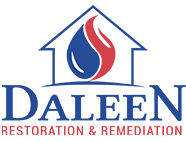Wisconsin winters can be harsh, and if you’ve had a roof leak from heavy snows, you may not realize that the leak can quickly lead to mold. Or, you may have experienced another type of disaster, such as water damage from a fire or flooding. Any natural disaster that leads to standing water, including pipes that were damaged or burst after a tornado or storm, is the perfect environment for mold to form.
Understanding the Dangers of Mold
Anyone with respiratory conditions, including allergies, asthma, COPD, or other breathing difficulties, are more sensitive to mold. Still, all family members and pets can be susceptible to health complications with prolonged exposure to mold. If you plan to be inside a mold-infested building for a while, or if you’re in the middle of cleaning up after water damage or a disaster, the CDC recommends that you wear N95 masks or a respirator with a higher protection level, and wear it the entire time you’re in the building.
How Does Mold Form?
Mold forms fastest in warm, moist environments, preferably those with little ventilation. That’s why you see it most in attics, such as if there’s a roof leak from a snowstorm or in basements, where most of the plumbing pipes and structures originate. Mold can form in the walls, too, if you have a leaking pipe. Sometimes, when Wisconsin winter temperatures drop, your pipes can freeze but not burst all the way, develop small leaks at the seams and joinings.
Standing water, caused by burst pipes, flooding, or water damage after a fire, is another cause of mold. This can be incredibly toxic since there may be bacteria from sewage pipes in the standing water. In these cases, it’s recommended that you get professional mold remediation services.
Preventing Mold After a Disaster
Depending on how quickly you’re able to clean up after a disaster, you may be able to reduce the amount of mold that forms or avoid it altogether. There are a few key things to do immediately after a disaster to minimize the mold forming in your building:
- Identify the source of the leak
- Turn off the water to prevent more from coming in
- Begin removing the water from the affected areas using a pump or other device
- Use fans to dry the area, pointing them at affected areas once the water has cleared
The quicker you’re able to remove the water and dry the areas, the fewer chances mold has to form.
Choose Professional Mold Services
Even though your building may look dry and mold-free to the naked eye, unless you’ve gotten every spore and speck, mold can still grow back. At Daleen Restoration, we’re professional mold removers. We use leading-edge technology and techniques to find all the mold, even if it’s hidden, and then safely remove it, preserving as much of your structure as we can. Visit us online, or save our number on your phone for help after a disaster.


 (262)-214-5021
(262)-214-5021